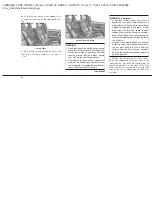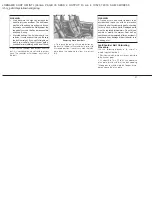
JOBNAME: CHRY OM INTL (Conten PAGE: 35 SESS: 2 OUTPUT: Fri Jun 4 10:52:37 2010 SUM: 451F4763
/chry_pdm/chrysler/owners/grc/og
When To Use The Automatic Locking Mode
Use the Automatic Locking Mode anytime a
child safety seat is installed in a seating posi-
tion that has a belt with this feature. Children
12 years old and under should always be
properly restrained in the rear seat.
How To Engage The Automatic Locking
Mode
1. Buckle the combination lap and shoulder
belt.
2. Grasp the shoulder portion and pull down-
ward until the entire belt is extracted.
3. Allow the belt to retract. As the belt retracts,
you will hear a clicking sound. This indicates
the safety belt is now in the Automatic Locking
Mode.
How To Disengage The Automatic Locking
Mode
Unbuckle the combination lap/shoulder belt
and allow it to retract completely to disengage
the Automatic Locking Mode and activate the
vehicle sensitive (emergency) locking mode.
Seat Belts In Passenger Seating
Positions
The seat belts in the passenger seating posi-
tions are equipped with Automatic Locking
Retractors (ALR) which are used to secure a
child restraint system. For additional informa-
tion refer to “Installing Child Restraints Using
the Vehicle Seat Belt” under the “Child Re-
straints” section. The chart below defines the
type of feature for each seating position.
Driver
Center
Passen-
ger
First Row
N/A
N/A
ALR
Second
Row
ALR
ALR
ALR
Third Row
N/A
N/A
N/A
•
N/A — Not Applicable
•
ALR — Automatic Locking Retractor
If the passenger seating position is equipped
with an ALR and is being used for normal
usage:
Only pull the belt webbing out far enough to
comfortably wrap around the occupants mid-
section so as to not activate the ALR. If the ALR
is activated you will hear a ratcheting sound as
the belt retracts. Allow the webbing to retract
completely in this case and then carefully pull
out only the amount of webbing necessary to
comfortably wrap around the occupants mid-
section. Slide the latch plate into the buckle
until you hear a
9
click.
9
Seat Belt Pretensioners
The seat belts for both front seating positions
are equipped with pretensioning devices that
are designed to remove slack from the seat belt
in the event of an accident. These devices
improve the performance of the seat belt by
assuring that the belt is tight about the occu-
pant early in an accident. Pretensioners work
for all size occupants, including those in child
restraints.
NOTE:
These devices are not a substitute for
proper seat belt placement by the occupant.
The seat belt still must be worn snugly and
positioned properly.
The pretensioners are triggered by the Occu-
pant Restraint Controller (ORC). Like the air-
33
















































